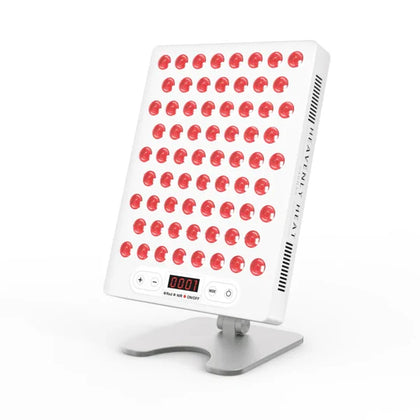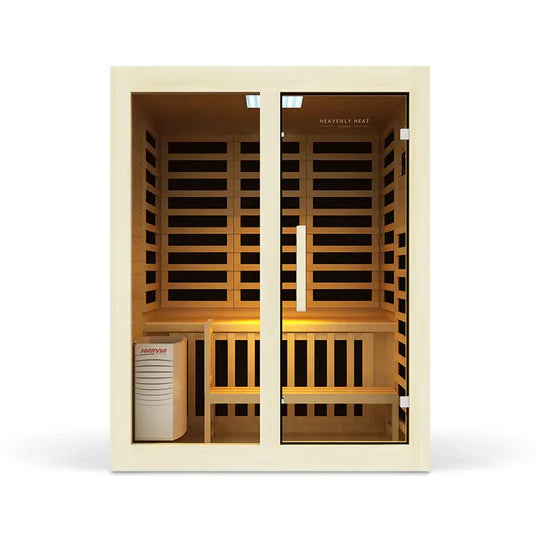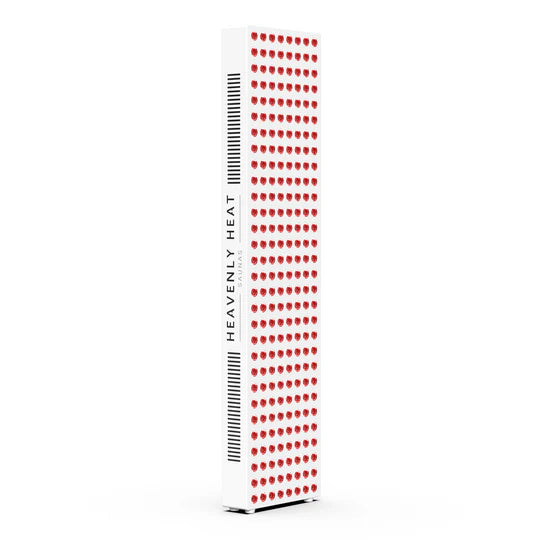Does Red Light Therapy Help Sagging Jowls?

Sagging jowls can make you feel older than you actually are, giving your face a droopy, tired appearance.
As collagen and elastin break down over time, this common sign of aging becomes harder to hide.
Ignoring it only deepens the issue, leaving you feeling frustrated and self-conscious. But there’s hope.
Could red light therapy be the non-surgical solution you've been searching for? Keep reading to find out!
Table of contents
Key Takeaways
-
Red light therapy stimulates collagen production, helping to tighten sagging skin, especially around the jowls.
-
Consistent use of red light therapy, combined with proper skincare, can improve skin elasticity and reduce the appearance of sagging.
-
Results from red light therapy typically become visible within 2 to 4 weeks, but ongoing treatments are needed to maintain improvements.
-
Protect your skin from further damage by avoiding sun exposure and smoking, both of which accelerate sagging.
-
When using red light therapy at home, choose a high-quality device and maintain a consistent routine for the best results.
What Are Sagging Jowls?
According to Medical News Today , sagging jowls refer to the drooping skin around the jawline, chin, and lower cheeks, an inevitable sign of aging as the skin loses firmness and elasticity.
Primary causes of jowls include:
Aging: Natural decline in collagen, elastin, and facial fat reduces skin’s ability to stay taut.
Genetics: Family history can predispose individuals to early or pronounced jowl development.
Sun damage: UV rays break down skin fibers, accelerating sagging.
Lifestyle factors: Smoking, poor hydration, and low-antioxidant diets deplete skin health.
Repetitive movements: Habits like frowning, gum chewing, or prolonged phone use strain facial muscles.
Sudden weight loss: Rapid fat loss can leave skin loose and unsupported.
Chronic stress and lack of exercise: These impair circulation and muscle tone, weakening skin structure.
Jowls may not be medically concerning, but they can significantly impact self-esteem, making people feel older or less confident. While surgical options like neck lifts are effective, less invasive alternatives such as facial exercises, hydration, and antioxidant-rich skincare offer practical management strategies. Techniques like facial yoga and Ultherapy show promising results. The good news is, with mindful care and consistency, it's possible to soften their appearance and maintain a more youthful jawline naturally.
The Science Behind Red Light Therapy and Sagging Jowls
Red light therapy is becoming a popular way to tighten sagging jowls without surgery or harsh treatments. In one study , women used a red light mask twice a week for three months.
The results were impressive, their skin looked firmer, smoother, and more lifted around the jawline. They also noticed fewer wrinkles and smaller pores.
Even after they stopped using the mask, their skin stayed better for at least a month. Another study with over 100 people found that red light helped improve skin texture and boosted collagen, which keeps skin tight and youthful.
Scientists believe this works because red light gives energy to your cells, helps them repair faster, and reduces the stress that causes aging. If you're looking for a safe, gentle way to fight sagging skin, red light therapy might be worth a try.
Common Causes of Sagging Skin
Loss of Collagen and Elastin
- Collagen and elastin are the reason your skin stays firm: These two proteins are what give your skin strength and bounce. Without them, the skin can’t hold its shape or tightness.
- As you get older, your skin makes less collagen and elastin: Starting in your late 20s, your body naturally slows down the production of these proteins, which leads to sagging skin over time.
- Less collagen and elastin means skin starts looking thinner and looser: When these proteins break down, the skin loses its ability to bounce back and starts to look weak and saggy.
- Eating too much sugar damages the collagen in your skin: Sugar sticks to collagen through a process called glycation, making it stiff and more likely to break down, this speeds up sagging,” says Arianne Shadi Kourosh , a board-certified dermatologist and Harvard Medical School faculty member.
- Sugar damage causes inflammation and weakens skin even more: Once collagen is damaged, inflammation follows, which makes the skin even less elastic and more prone to wrinkles and sagging.
- A high-sugar diet speeds up how fast your skin ages: What you eat matters, especially sugar. It plays a big role in how fast your skin loses collagen and starts to sag.
- Taking collagen supplements can help your skin stay firm: Collagen powders or capsules can improve your skin’s hydration, firmness, and elasticity, especially around areas like the jawline.
- Collagen loss becomes more obvious in your 40s and 50s: By mid-life, the lower collagen levels really show, especially as the skin around the jaw and cheeks begins to sag.
- Sun and smoking make you lose collagen even faster: Too much UV exposure and smoking break down collagen quicker, causing faster sagging and making your skin look older.
Gravity
- Gravity pulls down the skin around your jaw: Gravity slowly pulls the skin downward, especially around the jawline. This makes your jowls look loose and less defined over time.
- As you get older, gravity makes your face sag more: With age, gravity’s effects become more obvious. The skin on your face and neck starts to droop because it loses its firmness.
- Gravity also causes breasts to hang lower over time: Just like your face , your breasts are also affected. The skin and tissue can’t fight gravity forever, so they start to sag too.
- Gravity keeps shifting fat and skin all over your body: Gravity doesn’t stop, it keeps moving fat and pulling skin down, which leads to sagging in other parts of your body too, not just your face.

Loss of Facial Fat
- Losing a lot of weight takes fat away from the face too: Massive weight loss doesn’t just shrink the body, it also takes fat from the face, leading to looser and sagging skin,” says Dr. Janiene Luke , a board-certified dermatologist and Associate Professor at Loma Linda University.
- As we age, our face naturally loses fat: Over time, the fat that gives the face a full and youthful look starts to disappear, making the skin look less tight.
- Less cheek fat makes jowls more visible: When the cheeks lose fat, the skin below starts to sag, which makes jowls stand out more clearly.
- Stress and fast weight loss make fat disappear quicker: Not just aging, lifestyle factors like stress, rapid weight loss, and harsh treatments can speed up how quickly the face loses fat.
- Losing facial fat can make your jawline look hollow and saggy: When there’s less fat under the skin, the jawline begins to look more hollow, sunken, and loose.
- Less fat changes the whole shape of the face: The face can start to look different overall—more bony, with less roundness and softness, because of the lost volume.
- Creams and exercises may help a little, but they can’t bring the fat back: Non-surgical treatments can slightly improve skin quality, but they can’t replace the fat that’s been lost.
- Red light therapy tightens skin but doesn’t fix fat loss: This treatment may firm up the skin a bit, but it doesn’t restore volume or reduce fat where it’s needed, like in the jowls.
- Surgery is the only way to truly lift and remove jowl fat: For people with significant jowl fat, only surgical options can remove it and give a more lifted appearance.
- Weight loss combined with aging makes facial fat disappear even faster: Losing weight while also aging speeds up the loss of fat in the face, which leads to a drooping, tired-looking jawline.
Sun Exposure
- Sun exposure weakens the skin from deep inside: Sunlight doesn’t just affect the surface, it goes deeper and breaks down important parts like collagen and elastin, which keep your skin firm and tight.
- Too much sun makes your skin loose and saggy: When collagen and elastin break down from UV rays, the skin starts to lose its shape and begins to sag, especially around the jawline.
- Sun damage shows up early on your face and neck: The first signs of too much sun often appear as redness, dryness, and fine lines, mostly on areas like your face, neck, and chest that get the most sun.
- Staying in the sun too long makes you age faster: Over time, the more sun you get, the faster your skin ages. This can lead to drooping and loose skin, like sagging jowls.
- Daily sun protection keeps your skin looking young: Wearing sunscreen every day, covering up with clothes, and avoiding too much direct sunlight can help your skin stay firmer and younger-looking for longer.
Smoking
- Smoking weakens the skin from the inside: Smoking speeds up aging because the chemicals in cigarettes destroy collagen and elastin. These are the proteins that keep your skin strong and firm. Without them, your skin starts to sag.
- The jawline sags early because of smoking: One of the first places smoking shows its damage is the jawline. When the skin loses its strength, gravity pulls it down, and that’s when sagging becomes noticeable.
- Smoking blocks the skin from healing and staying healthy: Smoking reduces blood flow to your skin. That means less oxygen and fewer nutrients reach the cells, making it harder for your skin to repair itself or stay elastic.
- You can undo some skin damage caused by smoking: Treatments like Ultherapy help fix skin loosened by smoking. It uses focused ultrasound to lift the skin naturally and boost collagen, bringing back some of the tightness and bounce.
Poor Nutrition
- Not Eating Right Makes Your Skin Loose: Poor nutrition can also affect the firmness of your skin. Without the right vitamins and minerals, your body struggles to produce collagen and elastin, leading to weakened skin.
- Too Much Sugar Breaks Down Skin Strength: A diet high in sugar accelerates the breakdown of collagen, which speeds up sagging and the appearance of aging skin.
- Less Protein Means Less Tightness in Skin: A lack of protein reduces the skin’s firmness and elasticity, making it more prone to sagging.
- Eating Collagen Helps Skin Stay Firm: Incorporating collagen into your diet, either through supplements or collagen-rich foods, can help improve skin hydration and firmness, boost elasticity, and reduce the appearance of sagging jowls.
- Skin Needs Vitamins and Good Fats to Stay Tight: Essential nutrients like vitamin C, zinc, and omega-3 fatty acids are key for supporting collagen production and maintaining skin elasticity, helping to prevent sagging and keeping your skin firm and youthful.
Genetics
- Your family history affects how your skin will age: If sagging jowls run in your family, there’s a higher chance you might deal with the same as you grow older.
- Your genes control how much firmness your skin can hold: The natural amount of collagen and elastin your body makes comes from your genes, and these proteins decide how tight or loose your skin stays.
- Some people’s skin reacts worse to sun because of their genes: Your genetic makeup influences how your skin handles the sun and other outside damage, which can speed up sagging in some people.
- You can’t change your genes, but you can still protect your skin: Even though your DNA is fixed, using the right skincare, staying healthy, and protecting your skin can help delay the signs of sagging.
- Daily sunscreen use helps fight the aging your genes may cause: Wearing SPF every day shields your skin from sun damage, which is especially helpful if your genes already make you prone to early aging.

Summary
Sagging jowls happen over time due to aging, gravity, sun damage, and lifestyle choices. You can’t control everything, like genetics, but taking care of your skin with good habits, nutrition, and sun protection helps keep your jawline firmer and your face more youthful.
How Red Light Therapy Can Help with Sagging Skin?
Stimulating Collagen Production
- Red light wakes up your skin’s collagen factory: Red light therapy boosts a special enzyme in your cells that helps energize and wake up collagen production , especially with wavelengths like 630nm and 830nm .
- Collagen gets to work deep under your skin: When your skin absorbs red light, it activates collagen in the deeper layers , helping the skin feel firmer and more elastic over time.
- Regular use brings visible tightening: If you use red light therapy regularly for about 84 days , it can visibly reduce sagging skin by up to 24.8% , according to studies.
- Works well if your skin is only a bit loose: Red light therapy is great for mild to moderate sagging , but if your skin is very loose, you might need stronger treatments like fillers or surgery .
- Too much red light can harm your skin: Using red light the wrong way can lead to burns or blisters , so it’s important to follow safe usage instructions to protect your skin while boosting collagen.

Improving Skin Elasticity
When skin loses elasticity, it starts to sag, especially around the jowls. But when you improve elasticity, your skin gets firmer, tighter, and bounces back better instead of drooping.
That’s where red light therapy comes in. It helps your cells make more energy, boosts collagen and elastin (the stuff that keeps skin firm), and supports healthier skin from within.
In one study , women used a red light mask twice a week for three months and saw smoother, tighter skin with better elasticity.
Another study found red light also increased collagen and improved skin texture. That’s real, visible change.
Enhancing Circulation
Better blood flow can make a big difference when it comes to sagging skin. It brings more oxygen and nutrients to your skin cells, which helps them stay healthy, repair damage, and make more collagen, the protein that keeps your skin firm.
One study found that red light at 670 nm helps blood vessels open up by releasing natural compounds called S-nitrosothiols (RSNO).
These compounds relax the muscles around your blood vessels, letting more blood flow through.
According to the researchers, this happens because red light boosts tiny packages called extracellular vesicles, which carry RSNO out of the blood vessel lining to where they’re needed. This better circulation gives your skin what it needs to look tighter and more lifted over time.
Reducing Inflammation
When your skin stays inflamed, it breaks down the collagen and elastin that keep it firm and tight, making sagging worse over time.
Red light therapy helps by calming this inflammation so your skin can start to heal and rebuild. One study found that red and near-infrared light reduced swelling, lowered stress in damaged cells, and boosted cell repair.
Another study showed that red LED light cut down pain, swelling, and even stopped certain inflammatory cells from moving in. This calming effect gives your skin a better chance to stay firm and fight sagging naturally.
Promoting Cell Turnover
Red light therapy boosts cell turnover, which is essential for maintaining youthful-looking skin.
As the skin’s natural renewal process speeds up, collagen production increases, and fine lines begin to diminish.
|
Can Red Light Therapy Help With Sagging Skin |
Yes / No |
| Stimulating collagen production |
✅ Yes |
| Tightening sagging jowls |
✅ Yes |
| Reversing deep wrinkles |
✅ Yes |
| Improving skin elasticity |
✅ Yes |
| Stopping aging permanently |
❌ No |
| Boosting circulation |
✅ Yes |
Summary
Sagging jowls happen over time due to aging, gravity, sun damage, and lifestyle choices. You can’t control everything, like genetics, but taking care of your skin with good habits, nutrition, and sun protection helps keep your jawline firmer and your face more youthful.
Other Therapies that help with Sagging Jowls
Near-Infrared Light Therapy
Near-Infrared Light Therapy helps with sagging jowls by going deep into the skin and waking up the cells that make collagen, the stuff that keeps your skin firm and tight.
As collagen builds up, the skin starts to feel smoother and look more lifted. In a study shared by Mary Ann Liebert , Inc., people who used light in the 570–850 nm range twice a week saw real results, smoother skin, better texture, and more bounce. This makes near-infrared light a great option for lifting sagging jowls naturally.
How to Use Red Light Therapy for Sagging Jowls at Home?
Choose a High-Quality Device
- A good device has the right kind of light your skin needs: Not all red light is the same, look for one that uses 600 to 650 nm wavelength , because that’s the sweet spot for reaching your skin deeply enough to help with sagging.
- Strong and steady light gives better results: Cheap devices may flicker or lose strength , but a high-quality one gives your skin consistent light every time, which helps improve firmness over time.
- Face exercises make the device work even better: If you want faster results, add simple jaw and cheek exercises . These moves tone the muscles under your skin, and when used with red light therapy , the lifting effect becomes more noticeable.
Prep Your Skin Properly
Proper skin preparation before using red light therapy helps maximize its effectiveness. Start by thoroughly cleansing your face to remove dirt, oil, and makeup.
Using a gentle, non-abrasive cleanser ensures your skin stays balanced and doesn’t interfere with the therapy.
Hydrate your skin with a moisturizer, but avoid overly greasy creams, as they can block light penetration.
Be Consistent with Sessions
Red light therapy works best when used regularly. For best results, aim for daily sessions, each lasting around 10-20 minutes.
Skipping sessions can delay or diminish results, so stick to a routine. Collagen production requires time and consistency.
Maintain the Correct Distance
Maintaining the right distance from the device is crucial for optimal results. Holding the red light therapy device too close can cause irritation, while holding it too far may reduce its effectiveness.
For the best results, aim to keep the device 15 to 30 centimeters away from your skin.
You can easily measure this distance using a tape measure, ensuring consistent and even exposure for maximum benefits.
Combine with Skincare
- Using a hydrating serum first helps the red light work better: Before your red light therapy, apply a serum with hyaluronic acid. It keeps your skin moist and plump, which makes it easier for the red light to go deeper and work more effectively.
- Good skincare ingredients make the results even better: Adding serums with vitamin C, niacinamide, or peptides helps improve skin tone, texture, and brightness. These ingredients support what red light therapy is already doing for your skin.
- Regular use with skincare helps smooth and lift the skin: When you keep up this routine, red light plus good skincare, you'll start to notice smoother, firmer skin that looks younger and more refreshed.
Summary
With the right device, proper prep, consistent use, and a solid skincare routine, red light therapy can help lift sagging jowls over time. Stick with it, follow the tips, and you’ll see firmer, more youthful skin from home, naturally and effectively.
What Results Can You Expect from Red Light Therapy on Sagging Skin?
- Red light helps your skin feel tighter by boosting natural collagen: Red light therapy works by encouraging your body to make more collagen. This makes your skin feel firmer and can help lift areas that have started to sag, like around the jowls.
- Wrinkles slowly become less noticeable with regular use: Along with tightening sagging skin, red light therapy also helps reduce deep wrinkles. Over time, your skin will look smoother and younger.
- You can see small changes in just a few weeks: If you use red light therapy regularly, you may start seeing visible results within 2 to 4 weeks. The skin starts to look firmer and slightly more lifted.
- Bigger improvements take time and patience: Don’t expect fast results, this isn’t a quick fix. The therapy works slowly, and real changes become more noticeable after a few consistent months of use.
- It also makes your skin tone look better and more even: As a bonus, red light therapy helps improve your skin tone and texture. It gives your skin a smoother, healthier, and more even appearance overall.
Summary
Boosts collagen production to improve skin elasticity
Helps tighten sagging skin, especially around the jowls
Reduces the depth of deep wrinkles over time
Enhances skin texture, tone, and overall firmness
Visible improvements typically begin in 2–4 weeks with consistent use
Full results develop gradually over several months
Are the Results of Red Light Therapy for Jowls Permanent?
- Red light therapy can tighten jowls, but it doesn’t last forever: Red light therapy helps lift and firm sagging jowls, but the results fade over time. It's a great non-invasive option, but not a permanent fix.
- You’ll need regular treatments to keep seeing results: The skin improvements from red light therapy usually stay for a few months, but you’ll need repeat sessions to keep the jowls from sagging again.
- Combining treatments gives better and longer-lasting results: Using red light therapy with radiofrequency works better than using red light alone. Together, they give a stronger lift and help results last longer.
- Heat-based radiofrequency boosts skin tightening around the jaw: Radiofrequency treatments use heat to make your skin produce more collagen and elastin. This helps firm up the jawline in a deeper, more effective way.
- Deep radiofrequency is the top choice for jawline firmness: For people who want the best results, deep radiofrequency is considered the gold standard. It reaches deeper layers of skin for tighter, longer-lasting results.
- A few sessions a year can help you keep a younger look: Most people find that having sessions every few weeks or even just a few times a year is enough to keep their jawline looking firm and youthful.
Summary
Red light therapy results for jowls are not permanent but can last several months .
Maintenance treatments are needed to keep up results.
Works best when combined with radiofrequency (RF) treatments.
RF boosts collagen and elastin , improving skin firmness.
High-power RF is the gold standard for jawline tightening.
Periodic sessions (every few weeks or a few times a year) help maintain a youthful look.
FAQs
Who Shouldn’t Use Red Light Therapy for Sagging Jowls?
"If you have certain health conditions, you may need to avoid red light therapy for sagging jowls. People with autoimmune diseases, where the immune system mistakenly attacks the body, should be cautious, as it might trigger flare-ups. Pregnant women are also advised to avoid it due to limited research on its safety during pregnancy."
Should You Combine Red Light Therapy with Anti-Aging Skincare Products?
Red light therapy is popular for anti-aging because it stimulates collagen production, improving skin elasticity and reducing wrinkles. It also enhances the effectiveness of anti-aging products like creams, serums, and oils.
Can You Combine Red Light Therapy with Facial Massages for Jowl Tightening?
Red light therapy tightens the skin around the jowls by stimulating collagen and elastin production, which promote skin firmness and elasticity. The skin absorbs the light, encouraging the rebuilding of these proteins, particularly in sagging areas like the jowls.
Can You Use a Handheld Red Light Device for Jowls?
Using a handheld red light device for sagging jowls can be effective. Red light therapy penetrates the skin with low-level wavelengths of light, stimulating collagen production to tighten and firm the skin.












































